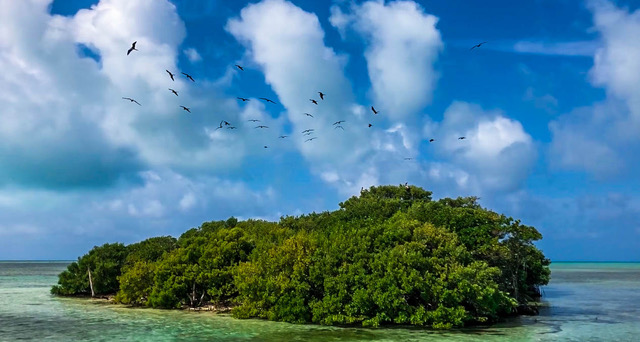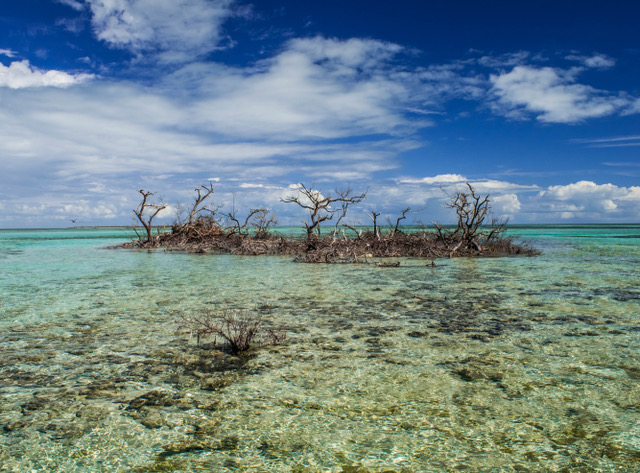Spearheading Conservation: ENGOs Driving Change, Bonefish & Tarpon Trust
May 14, 2021
Brush Cay mangrove forest before Hurricane Dorian
As society transitions into the next decade, it has become increasingly clear that the Climate Crisis is an impossible battle to fight alone. The environmental movement is growing globally as governments, companies, and organizations redirect together towards a green future. A myriad of environmental non-governmental organizations [ENGOs] act as a powerful force within this movement guiding change, including groups like The Nature Conservancy, Greenpeace, and Sierra Club, among many others. ENGOs are critical to the sustainable progress the world is making to conserve critical lands and waters, acting as liaisons to successfully transfer knowledge among stakeholders (van Kerkhoff and Lebel, 2006).
Bridging the gap between science and action is a difficult task to tackle. It is crucial to an environmental organization’s mission to ensure engagement across all fields of knowledge and power to achieve goals (Brownscombe et al., 2019). Using in-depth study techniques and science-based data in combination with a strong relationship with local and state governments and other stakeholders, ENGOs like Bonefish & Tarpon Trust have been able to achieve success in projects of small and large scales alike.
Ecosystem Protection
Bonefish & Tarpon Trust [BTT] is an ENGO based in southern Florida focused specifically on conserving bonefish, tarpon, permit — the species, habitats, and the larger fisheries they comprise. The organization, which pursues its mission through science-based conservation, education, and advocacy, was founded in 1997 by a group of concerned anglers seeking to reverse the declines they were witnessing in bonefish and tarpon populations in the Florida Keys (BTT History, 2018). Initial research efforts focused on bonefish tagging to collect much-needed data on population baseline, size, growth, and range of movement and satellite tagging of tarpon to learn more about their movement patterns. As the organization and funding grew, so did the scope of work, allowing BTT to embark further upon in-depth studies of other marine species, including permit and snook. Later broadening its grant-funded research efforts across the Caribbean basin to include the Bahamas, Cuba, Belize, and Mexico, BTT has since worked tirelessly to protect not only the marine species in those areas, but also their critical habitats and the surrounding communities who depend on those ecosystems.
Since its creation, Bonefish & Tarpon Trust has strived to align with its original mission, ensuring that work is produced through science-based research that supports all of the stakeholders. While this does include donors and partners, BTT focuses heavily on the wellbeing of the communities in which it works. The towns and regions in which BTT does research and large projects depend heavily on the specific ecosystems involved to support their local — and sometimes national — economies. It is for this reason that the organization is extremely conscious of these communities and aims to include them as the most important stakeholders in the projects. Through this method, BTT is able to act as a middle-ground for large donors and partnering corporations, local and state governments, and smaller communities that are more heavily impacted by the effects of land use and pollution.
The organization and partners can boast impressive accomplishments achieved through the years, including, but not limited to, research that is guiding management strategies of the Florida Keys National Marine Sanctuary and Everglades National Park, engagement of local anglers in Florida’s ongoing water management crisis through the “Fix Our Water” campaign, and assistance in the establishment of six nationally-protected bonefish conservation zones in the Bahamas (BTT accomplishments, 2019).
Hurricane Dorian and Mangrove Forests
Most recently, Bonefish & Tarpon Trust has worked to ameliorate the environmental destruction in the Bahamas brought on by Hurricane Dorian. In September 2019, Hurricane Dorian, an extremely powerful and devastating Category 5 Atlantic hurricane, struck the Bahamas as one of the most intense tropical cyclones in the region. Having stalled over the northern Bahamas, Dorian caused extreme and extensive ecological damage, destroying a massive percentage of the region’s mangrove forests, which are critical to the health of the surrounding ecosystem and the safety and wellbeing of the neighboring communities (Sean Rolle, 2020).

Given the apparent large-scale mangrove killings and importance of the forests to coastal ecological integrity, BTT initiated a formal damage assessment mapping project using field observations and remote sensing to estimate the extent of mangrove damage and mortality for the purpose of guiding restoration efforts. Using the data from this research the team was able to establish the most critical replanting zones. BTT has since partnered with relevant stakeholders in the region, including local governments and communities, private companies, and other ENGOs to transplant as many mangrove propagules as is feasible over the next five years to enhance recovery of the Bahamian mangrove ecosystem.

Through this initiative, critical coastal areas that were once protected by extensive mangrove root systems will be conserved and important species that inhabit mangrove forests in the area will return safely. Furthermore, local communities that benefit heavily from the presence of mangrove forests will be able to persist healthily once more, with fisheries and famous tourist sites that contribute up to $169 million annually to the Bahamian economy having been restored after a devastating loss (Large-Scale mangrove restoration…, 2021).
Governments are created to represent their constituencies, though it is often difficult for individual stakeholders to find pathways by which to communicate their needs to their representatives. Non-governmental organizations create a middle ground. By interacting with individual stakeholders and uniting on a shared cause, NGOs are able to act at the forefront of a mission driving change. Environmental non-governmental organizations like Bonefish & Tarpon Trust, while perhaps not powerful on their own, are made strong by engaging with stakeholders, including scientists, local communities, and private partners to form a united front fighting the effects of climate change.
Literature Cited
Brownscombe, J. W., Adams, A. J., Young, N., Griffin, L. P., Holder, P. E., Hunt, J., . . .Danylchuk, A. J. (2019). Bridging the knowledge-action gap: A case of research rapidly impacting recreational fisheries policy. Marine Policy, 104, 210-215. doi:10.1016/j.marpol.2019.02.021
BTT accomplishments. (2019, January 09). Retrieved from https://www.bonefishtarpontrust.org/btt-accomplishments/
BTT History. (2018, November 29). Retrieved from https://www.bonefishtarpontrust.org/history/
Large-Scale mangrove restoration project begins in the northern bahamas. (2021, January 26). Retrieved from https://www.bonefishtarpontrust.org/blog/2021-01-26-large-scale-mangrove-restoration-project-begins-in-the-northern-bahamas/
Sean Rolle, A. (2020). The First Line of Defense: Mangrove Restoration Set to Begin in Northern Bahamas. Bonefish & Tarpon Journal, (Fall 2020), 58-61. Retrieved from https://issuu.com/bonetarpontrust/docs/bttjournalfall20singles/60
Stelzer, R., & Kashian, D. (2014). The role of conservation partnerships between scientists and nonprofit agencies in freshwater science and management. Freshwater Science, 33(2), 670-673. doi:10.1086/675770
van Kerkhoff, L., and L. Lebel. 2006. Linking knowledge and action for sustainable development. Annual Review of Environmental Resources 31:445–477.
About the Author
Written by Miranda Wolfe, an IE Cleantech Corner intern from the Class of 2021 at the University of North Carolina at Chapel Hill. She earned a B.A. in Environmental Studies with a concentration in Sustainability, and a B.A. in French and Francophone Studies.
